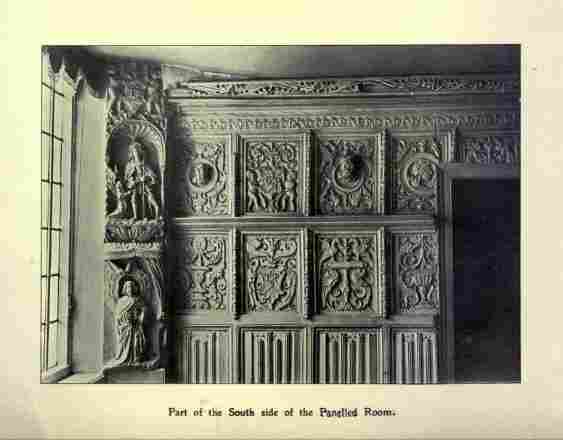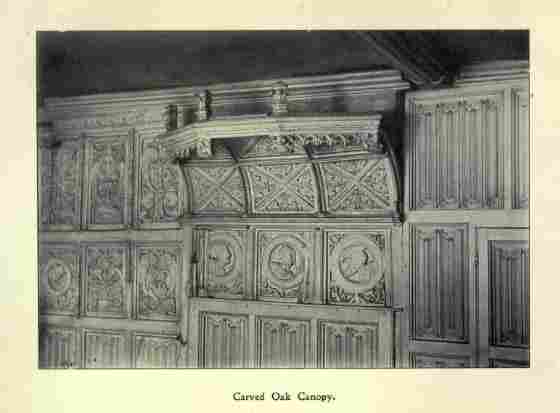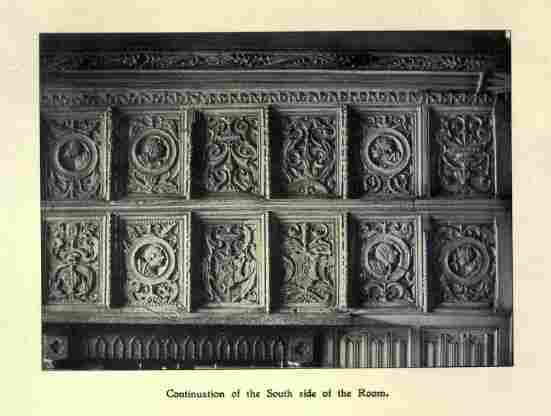Ashburton Burgh Answers
'A piglet killed a child.........value of the piglet 3d'
Crown Pleas of the Devon Eyre of 1238 Henry Summerson Devon and Cornwall Record Society 1985, p118
* Ashburton people in Crown Pleas of the Devon Eyre* of 1238 *
Geoffrey le Faucher, living in Ashburton tithing, was outlawed with another man for the death of John the marshal.
Ashburton was in mercy.**
* ******** *
William Alisande, living in Ashburton, killed William le Mazacrer and fled.
Ashburton was in mercy for not producing him.
* ******* *
Joel Kide, Walter le Chapman and John Barat sold wine contrary to the assize.***
All were in mercy.
Crown Pleas of the Devon Eyre of 1238 Henry Summerson Devon and Cornwall Record Society 1985, pp113, 118
*An eyre was a periodic inspection by the King or by justices of the King
** To be in mercy was to be liable for a financial penalty, or amercement, to be paid to the King.
*** An assize was a meeting of vassals (free men with obligations to a lord) with the King, and the decrees issued afterwards.
http://www.hemyockcastle.co.uk/feudal.htm Accessed 12-10-2013
* ******* *
William Geffrey, also born on the Bishop's manor of Ashburton, had received his manumission on June 6th.
The Register of Edmund Stafford (1395-1419), Rev F C Hingleston, London 1886, 9 index
ibid 111 index
*******



'Inconsiderable vestiges of a chapel, which belonged to the abbot of Buckfastleigh, are still discernible in the walls of a house occupied by Mr. Parham.'
A Topographical Dictionary of England, Samuel Lewis (ed) 1848, pp 77-81
'W.P.S.' writing in the Exeter Flying Post in 1851, says that it is erroneous to think that the house belonged to the abbot of Buckfastleigh.
Exeter Flying Post 4 September 1851 p6 col5
The 1891 census shows an Edward and Elizabeth Cruse living in West Street. Edward is 70 and living on his own means; Elizabeth is 71.
Edward Cruse died in June 1905 and was laid to rest in the Parham vault.
Western Times 30 June 1905 p12 col5
In August 1905 Sawdye and Son sold a large amount of antique furniture, paintings and china from Paradise House in West Street, on the instructions of the representatives of the late E Cruse. The panelling is not mentioned.
Western Times 18 August 1905 p2 col1
1590 Gift and bond from Christopher Lange of Ashburton, glover to John Blundell of Ashburton, merchant March 26th, for a close of land, consideration £11.
OCLC (online computer library centre) number
434516091.
1600 Bargain and sale from Christopher Lange of Ashburton, glover to George Crust of Ashburton June 25th.
OCLC number 430230339
1633 Lease for lives from Sir William Strode of Newnham to William Avoke of Ashburton, yeoman May 2 For close in Asburton, consideration £40
OCLC number 423392555
1637 Lease for lives from Sir George Sondes of Theowley, Kent, to Lady Helen Parkhurst, Robert Parkhurst and George Fabyan of Ashburton, yeoman. A messuage in Ashburton, consideration £80
OCLC Number: 423395615
1639 Bargain and sale from Sir Richard Strode of Newingham to Thomas Cruse of Ashburton, gent for close in Ashburton consideration £37
OCLC Number: 430230286
Whereabouts of the above documents are unknown. Reference accessed through https://www.google.com - 23-02-2015
*******
Items connected to Wills have now moved to a separate sub-section
*******
In 1585 Queen Elizabeth restored to the vicars choral* of Exeter Cathedral various lands. These included a close at Stonehill, within the borough of Ashburton.
The History of Exeter, George Oliver, Exeter, 1821,p86ff
*Described in a paper by Peter Hampson as 'choristers and property dealers' https://humanities.exeter.ac.uk/media/universityofexeter/collegeofhumanities/history/exhistoria/volume4/Hampson-Vicars_Choral.pdf - Accessed 06-10-2016
*******
Taken from the Subsidy Rolls and described in a paper read by J S Amery in 1896, these names come from an assessment of people's land and goods,on which they had to pay an amount of money. The paper was published in the Transactions of the Devonshire Association, and is available freely through https://archive.org/. The forenames towards the end of the list are only partially visible in the scanned documents.
Peter Brendon gen
Sampson Litheby gen
Gawin Seintclere gen
William Matthews
Joan Elis widow
Thomas Ffursman
Baldwin Guye
William Taylor
Alicia Windyeat
Richard Knolling
John Hannaford
John Ffurse
William Cann
William Byrte
William Ffraunces
Henry Fforde
Thomas Cole
Margery Bowcher
John Langford
Henry Hole
John Taylour
Thomas Elis
Thomasine Comiatt
Pasc Payge
Thomas Lowman
Nicholas Widecombe
John Lucye
Thomas Riche
Ed. Picke
Phelip Caunter
Roger Caunter
John Willmote
John Baron
Alexander Meacombe
William Warren
Ursula Mychell
Thomas Mitchell
Maria Cole widow
Elizabeth Ball
Elizabeth Wreyford
William Stephen
Christopher Meacombe
Thomas Aisheweeke
Ehechiel Castledon
John Tozer gent
Anna Castledon
John Castledon
Nicholas Prynne
Gabriel Harrys
Christopher Preston
John Ffurse of Brownswill
William Pattye
Leonard Myller
Bernard Dolbear
George Kollinge
John Blundell
John Ffurseman
John Caunter
John Dolbear
John Bounde
John Haley
John Hexte
William Shorte
Thomas Ogyer
Alexander Shapter
Roger Bernarde
Michaus Knolling
William Knolling
Lucae Light
William Miller
Thomas Harrys
...eorge Ffabyan
...hristopher Sherwill
...illiam Bridgeman
...hn Dolbear senior
...lter Bond
...nry Crocker
...xander Bilsford
...hard Ffurse
...n Ffrowde
...ry Whitewaie
...liam Luscombe
...mas Bound
...ilda Berrye
...n Cowche
...ry Luscombe
...istian Kelley
...anna Meacombe
...mas Tonye
...well Ffurse
...liam Kollinge
...mas Matthewe
...n Stephen
...hard Noseworthie
...lliam Noseworthie
...n Furse
...tilda Leer widow
...hard Harell
...n Wyndeate
...lliam Knollinge
...omas Denbande
...gory Meacombe
...illiam Werren
...drew Tomlyn
...omas Churchwaie
...hn Ffrinde
Transactions of the Devonshire Association vol. 28 (1896) pp. 247 ff
Viewed through https://archive.org/. Accessed 8-11-2013
Wardens: John Roger gent and Thomas Arscott.
Overseers of the power: William Stevens, Thomas Oger, Richard Harell, George Ffabian.
Thomas Fford gent
James Woodlye gent
Peter Brendon gent
John Davis gent
Gawen Sainctler gent
Ffrancis Fforde gent
Sampson Lethebye gent
Leonard Miller
John Lucie de Priestaford
Edward Peeke
Georg Wythicombe
Thomas Ashwick
William Mathew de Somerhill
William Knowlinge de Somerhill
William Stevens
William Warryng de Ledburye
Johan Meacombe widow
Gregorie Meacombe
Roger Caunter
Richard Baren
John Robyns
Paschen Paidge
William Patye
Richard Nosworthy
Walter Band
John Wyndeat
Edward Wreyford
John Wilmett
William Nosworthy
Henry Berrye
William Stronge
Vrsula Muchell
Thomas Muchell
John Tozer gent
John Casteldon
Jane Ffurse widow
Henry Ffurse
John Ffurse de Waye
Mawd Berrye widow
Christopher Berrye
John Ffurse de Alston
Alexander Meacombe
Elizabeth Wreyford widow
Chrystofer Meacombe
William Warringe de Caten
Henry Crocker
Mary Cole widow
Julian Baren widow
Henry Whytwaie
William Luscombe
Henry Hole
John Tayler Senr
John Tayler Junr
Katheryne Ffrood widowe
Peternell Ffurse widowe
William Ffurse
Edward Ffurse
Johan Fayrmouth widow
Philip Eales
Georg Reynell
John Cooch
Richard Harell
Mrs Townesend
Thomas Tonye
Thomas Denband
Christian Kelly widow
Christofer Kelly
Ellerye Luscombe widow
William Vinch (Ffinch)
James Preston
Thomas Leeman
Andrewe Browne
Richard Miller
Henry Fford
Thomas Rich
Thomas Hale
John Hext
Adam Jaxon
Henry Heithfield
Ralfe Bullocke
Richard Grym
Henry Luscombe
Robert Typpett
Bauden Gaye
Nicholas Cater
Christofer Ffrinch
Thomas Adiscote
John Ffursman
John Bound
Nicholas Knowlinge
John Dolber Jnr
William Brigeman
Christofer Lange
Roger Denband
Henry Denband
Thomas Gotham
Philip Caunter widow
Christofer Shirwill
Philip Bicham
Edward Balle
Davy Reene
Richard Knowling
Christofer Preston
Barnibe Hals
John Halye
William Byrt
Bernard Dolbear
Thomas Hanaford
Alexander Shapter
Christofer Whitewaye
Robert Bound
Nicholas Pryne
Ezechiell Casteldon
William Caun
Henrye Dolber
John Ffrend Senr
John Ffrend Jnr
Thomas Ffursman
William Ffursman
Mathew Adam
Nicholas Ffursman
Georg Knowling
William Knowling pewterer
John Pryme
John Hale
Thomas Oger
William Tolchard
William Miller
John Langworthye
William Shorte
George Cruse
William Tailer
Richard Christofer
Lawrence Ffrinde
Bartholomew Aishridge
Georg Ffabian
William Mathew Snr
John Dolbear Snr
Thomas Harris
John Blundle
John Tucker
Gregorye Collings
Lawrence Abraham
John Quinte
Christofer Caunter
John Caunter
Thomas Leere
Thomas Eales
John Tooker cutler
Bartholomew Ashwick
John Wreyford
John Woolcote
Transactions of the Devonshire Association vol. 28 (1896)pp. 253 ff
Viewed through https://archive.org/. Accessed 15-11-2013
John Ball William Ffurse Henry Paddon John Hall'
Edward Windeatt, Early Nonconformity in Ashburton, Transactions of the Devonshire Association vol. 28,1896, p229
1636 Mr Townsend granted new lease of tenement at Chewly in Ashburton (also spelt Chevely and Chuleigh)
D&C3557 P13
1660 Jo. Short purchased a tenement formerly in the possession of Richard Knowlies D&C3559 P1A
1661 Richard Knowling granted lease of a tenement, provided he pay back rent of £7 to Widow Short D&C3559 PP115-117
1663 Confirmation of lease by George Prowse, vicar of Ashburton, to Thomas Kelly D&C3559 PP386-387
1668 Richard Knowling granted lease of tenement D&C3560 P43
1675 Richard Knowling granted new lease of tenement D&C3560 PP326-327
1689 Confirmation of lease to Richard Knowling D&C3562 PP158-159
1696 Confirmation of grant by John Bastard, vicar of Ashburton, to Richard Knowling of messuage and tenements D&C3563 P30
1696 Richard Knowling granted lease of tenement D&C356328-29
http://www.exeter-cathedral.org.uk/learning/library-and-archives1/library-and-archives.ashx - Accessed 17-2-2016